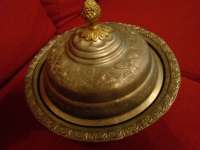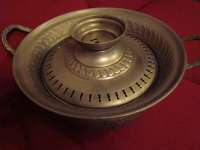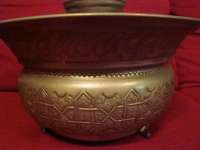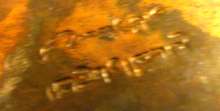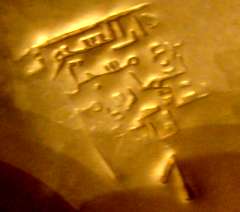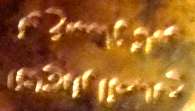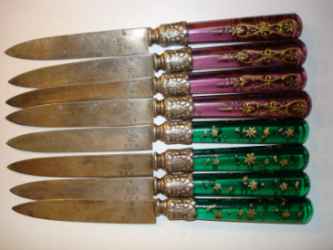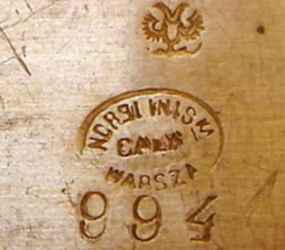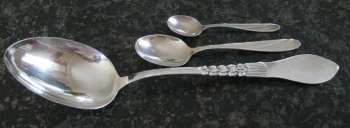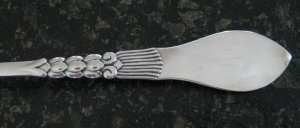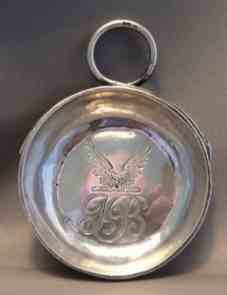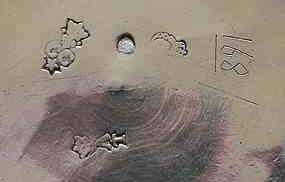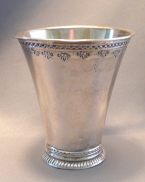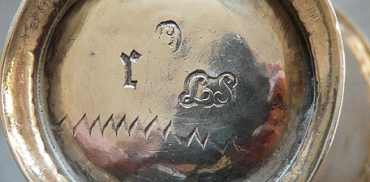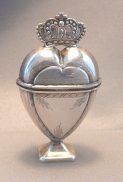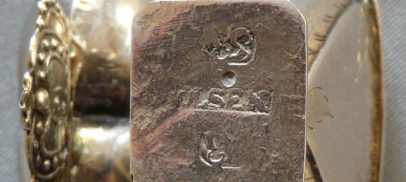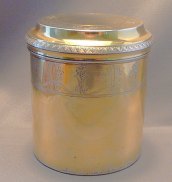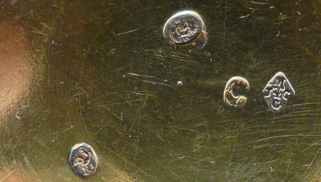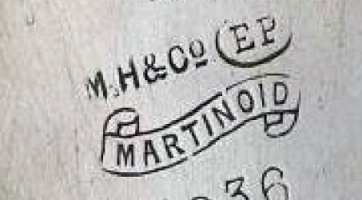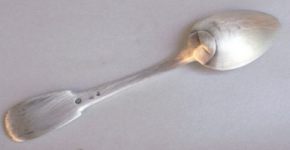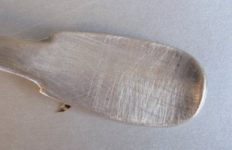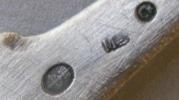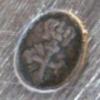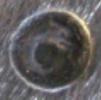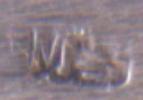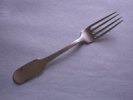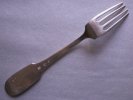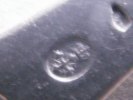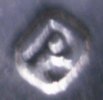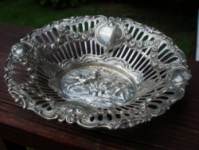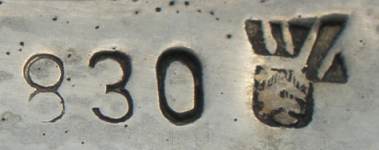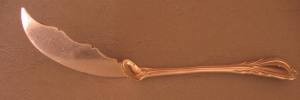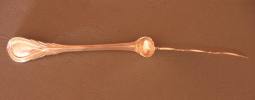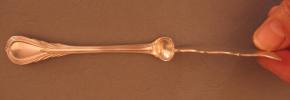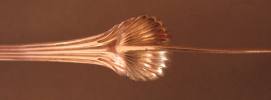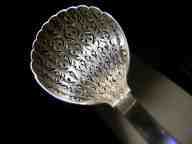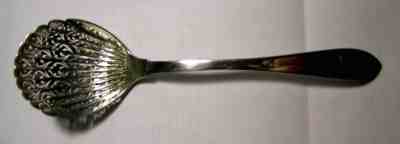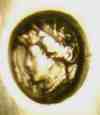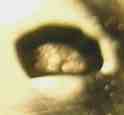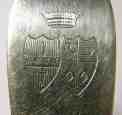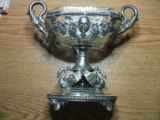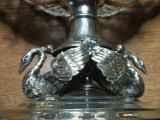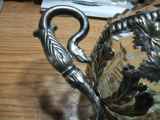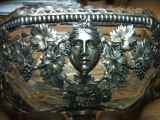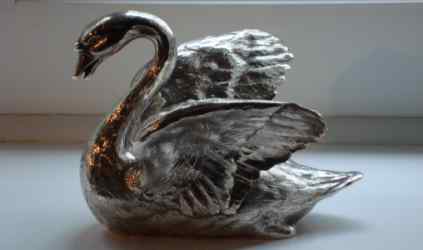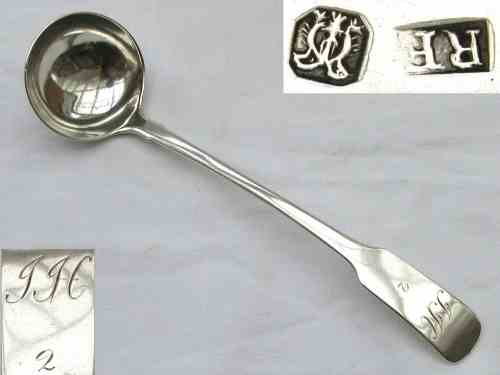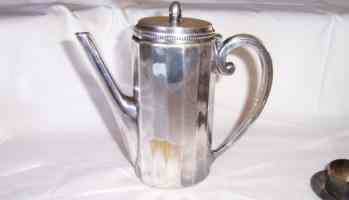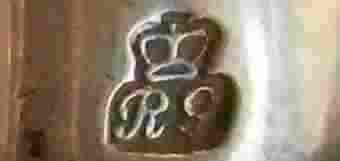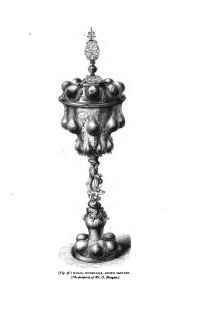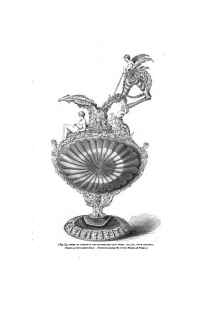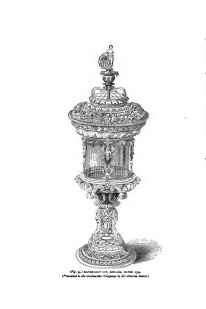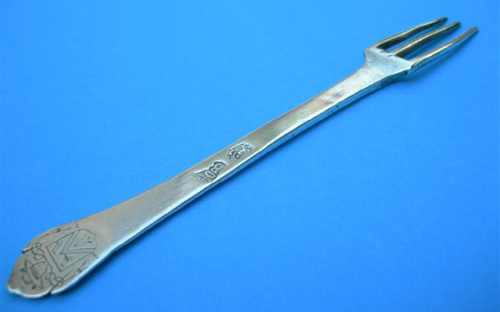
Christophe Ginter presents
an article written in three versions (English, French
and Italian):
A Burgundian fork dated 1660 
Une fourchette bourguignonne datée de 1660 
Una forchetta borgognona datata 1660 
.....During a recent auction, it was my pleasure to
appraise the fork represented above. The fork was
produced about 1660 in the town of AUTUN in Burgundy (of
which the capital is DIJON).
Today Autun is a small town of 16500 inhabitants. Autun
was, during the seventeenth century, an important
bishopric.....
click here  click
here click
here  click
here click
here 
|
Welcome to new ASCAS members:
Kriss Dillemans - Belgium
Piero Eduardo - Italy
Peter Ehrenthal - USA
Stephen Marsh - England UK
Antonio Piccolo - Italy
Alexandr Romanovskiy - Russia
Peter Trunzo - USA
Carla Veasy - USA
Naved Yar Khan - India
Members' Window # 65
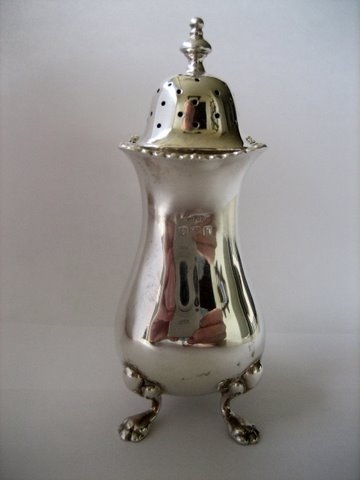
Robert Massart presents:
Silver Pepper Pots of the 19th & 20th Century 
To spice the taste of our meals, using a pepper pot, is
an everyday custom for all of us. Actually pepper
casters or dispensers of pre-ground pepper are
manufactured in all kinds of materials and shapes; even
silver pepper pots or crystal pepper pots topped with a
silver lid are still in use in households for special
occasions. In past centuries only nobility and the
wealthy bourgeoisie used silver objects to beautify
their table setting and impress their guests......
click here 
|
The help of ASCAS members will be greatly appreciated
Giorgio Busetto
Geldolph Everts writes:
...With reference to Prof. Nikogosyan's article (WIN 57) on
Polish (silverplate) marks, I am sending you a photo of the mark
I found on a set of 'Norblin i Ska' fruit knives in my
possession. As will be seen from the marks, the double-headed
eagle is of a more stylised form which suggests a date after
1895 (when the eagle was still traditional, see image no 12) and
1915 (when the eagle apparently was no longer in use). Also, the
word GALW is not followed by a colon or dot. Furthermore, WARSZA
is mentioned instead of WARSZAWA. The number 994 may refer to
the (silver-zinc?) content used in the hot-dip/electroplate
process (your advice will be welcome), but the knives have no
other marks, so maybe they are just of alpaca. The size of the
oval is 5x7 mm.
With best regards,
Geldolph Everts
First about the mark. It looks very inaccurate. Instead
of WARSZAWA (Warsaw) it is written WARSZA. It is hard to
imagine any western mark with a wrong spelling of their own
country or capital city. The same refers to the image of the Russian
eagle, which is too simplified and possesses no crown above the
double-headed eagle. There is no dot or colon after the
inscription GALW. Besides, the capital letter "I" instead of "i"
is used in the expression "NORBLIN i Ska".
From my point of view, this mark looks like a forgery and was
created by people not very familiar with the Polish language.
Another point is the material from which the handles of these
fruit knives are made. It is colored organic glass (poly-methyl
methacrylate), which was not used in before 1925. But it is also
obvious that the Polish mark with Russian eagle couldn’t exist
after 1915.
So, I am sure this set of fruit knives is a forgery (probably
made in China or somewhere in the East).
Best regards,
David Nikogosyan
Claudio Morelli writes:
...can you help me? This is a cigarette holder of wood and
silver. I can not understand its origin and year of production.
Thanks for your help.
Claudio Morelli
***NO ANSWER WAS YET RECEIVED FIR THIS QUESTION***
I believe that your spoon is silver plate and not solid
silver. Any suggestion by ASCAS members will be highly
appreciated.
Giorgio Busetto
Any help with these marks would be greatly appreciated and
of great help to me in cataloguing my collection.
Thanks and regards
Peter Barnes
Great challenges for ASCAS members. Identification of marks needed.
Giorgio Busetto
David McKinley writes:
Dear Giorgio, Once again I must thank you for the newsletter and
for all your work in putting it together.
I would like to reply to Peter Barnes (see
September Newsletter) please
as follows:
I would like to thank Peter Barnes for his kind words and for
the picture of his de Lamerie mote spoon. That the 'barb' on his
spoon is so like the one on mine means that mine is not unique
and this supports its authenticity but more than that it helps
me to make a possible attribution of the maker of my spoon. de
Lamerie had a close association with George Wicks (he supplied
plate to the Prince of Wales through Wicks) and the two may well
have shared design ideas which would thus be peculiar to them
and nobody else. The maker's mark on my spoon takes the form of
an upper case 'G' followed by some scratches which are
unreadable. George Wicks registered a mark in 1735 comprising
the letters 'G W' crowned!
Thank you again Giorgio.
David
Eddie Robinson writes:
...George,
I haven't spoken for a while. Keep the news letters coming they
are both interesting and great value.
I am in need of your help with finding the age of the attached
pic.
It is at the base of a hotel style Water/Coffee pitcher. M.H &
Co Martin Hall & Co Sheffield
Have a terrific day.
Eddie from down under
I found this information:
"Martinoid is a trade mark used by Martin Hall & Co in the
period 1880-1934"
and also
"...At the British Industries Fair of 1915, where they had one
of the largest stands, Martin, Hall & Co Ltd had an excellent
display of silver and E.P. goods, from large silver bowls and
presentation cups down to spoons. There was practically every
article one can think made of these metals. For the cheap trade,
the firm make the same varieties of goods in a patent white
metal called "Martinoid", which is claimed to hold the premier
position in the amalgams of the trade, possessing all the
non-corrosive properties of Britannia metal which it has now
superseded, and in addition is unequalled for colour, hardness
and durability, whilst its close grain gives the metal a fine
ring and finish equal in appearance to sterling silver.
Martinoid goods have become very popular on account of their
cheapness, and large quantities have been sold in this country,
but also in the Colonies..."
Giorgio Busetto
Marks on the spoon:
besides the "cross" and the "dolphin" there is a rubbed mark
that I believe to be M.F. belonging to Ferrando Mario, Nizza,
1847
Marks on the fork:
besides the "cross" there is the mark of Nizza Assay Office (a
hand: see in my website at http://www.silvercollection.it/TORINOHALLMARKS.html
) and the mark of
silversmith Poton Enrico, Chambery, 1847 (P.)
Giorgio Busetto
Robert Barry writes:
...Years ago I purchased this item from a dealer, who had little
information to offer beyond "probably continental". It is a
silver basket of reticulated design featuring garlands of roses
and a scene with two cherubs and kissing birds. The basket
measures 6 ½ x 5 ½ x 1 ¼ inch deep, and weighs about 4 ozs. The
hallmarks on the back have so far eluded my identification.
Can anyone tell me its origin?
Thank you.
Bob Barry
Your item is a piece of "Hanau Silver" (Germany) made by
Wilhelm Ludwig (1935-1972). Information about Hanau silver in
ASCAS website at http://www.ascasonline.org/articolo13.html
Giorgio Busetto
Any suggestion will be welcome
Giorgio Busetto
Replies to questions
José Luis Muñoz writes:
...in September Newsletter Alessandro Colemann requests
information about the mark of his sugar sifter. The silversmith
is Clérin Aimée Catherine (widow Lecour) 12 Rue Bailleul, Hotel
d'Aligre, 11 Place Thionville (1813), (Place Dauphine) Paris.
José Luis Muñoz
Christophe Ginter writes:
Regarding Alessandro's question, the French silversmith is a
mistress, Aimée Catherine Clérin, widow of the maker Mr. Lecour.
The mark shown here is her third one. The mark was used as from
1818.
Christophe
Charles C. Cage writes:
Alessandro Colemann’s French Restauration-era sugar sifter
bears Paris touchmarks for first standard (.950) silver,
1819-1838. The maker’s mark "ACC" with a crowned cup belongs to
Aimée Catherine Clérin, the widow Lecour. She was first
registered in 1807, though this particular mark was not
registered until 1818. There is no record of its cancellation,
but a mark with the same device was registered in 1830 at the
same address (11 place Dauphine) by François-Marie Lecour,
presumably her son.
Hope this helps!
Charles C. Cage
Charles C. Cage writes:
...Gerald Gerhart’s sugar basin is second quarter 19th
century Berlin, Germany. The Berlin guild was unusual in that,
beginning in 1819, each piece submitted to them was generally
marked by two assayers: the primary assayer (the
Zeichenmeister), and the secondary assayer (the Wardeinmeister).
The primary assayer’s letter appeared within the city mark (a
rampant bear) and the secondary assayer’s letter appeared alone.
Here, the mark on the right is that of Berlin primary assayer J.
C. S. Kessner, who served 1819-1854 (rampant bear with the
letter "K"); the mark on the left is the mark of Berlin
secondary assayer B. G. F. Andreack, who served 1819-1842 (the
letter "A", here inverted in relation to the other marks). The
maker’s mark in the center, though worn, is almost certainly
that of Berlin silversmith Johann Georg Wilhelm Peters
(1793-1864); Master 1829 ("WP", script, in an oval).
Charles C. Cage
Michael Yabsley receives this mail by Richard Hoskin after
his request of contact in June
2007 Newsletter
I came across the appeal by Mike Yabsley in Newsletter #38
June 2007 when I googled Queen Victoria’s godchildren. Can you
please forward it to him?
I have in my possession a silver swan which was allegedly a
christening gift by Queen Victoria to one of her godchildren. My
grandmother bought the swan at a church fete in Cornwall during
the 1930’s for 1 shilling, and it was believed to have been
donated by a Mrs Bradstock. I have been unable to trace the
origins of this lady or her maiden name.
The swan is hallmarked with a maker’s mark that looks like TS WS
HH (Thomas Slater, William Slater & Henry Holland) and I think
it’s dated 1895.
During my research I found an article that says the young
Queen Victoria who had many godchildren ordered a standard cup
from Mortimer & Hunt; this would seem to cast doubt on the gift
of a silver swan.
I would be grateful if you are able to shed any light on this. I
attach a photograph and look forward to hearing from you.
Richard Hoskin
In August Newsletter we made a "Scottish" hypothesis about
the mark of John J. Yale's fiddle pattern ladle
(see August 2009 Newsletter)
Robert Massart writes:
...Dear Giorgio,
In newsletter 63 of August 2009, John J.Yale wondered if his
toddy ladle was of Scottish origin.
After contacting the Edinburgh Assay Office I was informed that
they showed the marks to the curator of the National Museum of
Scotland, who stated that he was pretty sure the marks are not
Scottish.
Regards,
Robert
Jeff Christensen receives this reply about Hermann's mark
of his champagne bucket
(see September 2009 Newsletter)
David Nikogosyan writes:
...Recently I got a letter from one woman possessing a
coffee-pot from Herrmann bearing the stamp found by Jeff
Christensen (lion symbol, J L Herrmann with letters AG) and a
characteristic detail similar to that on the champagne bucket.
This piece (see photo attached) is surely made after WWI, in the
twenties-thirties, as it has a very characteristic knob used
from that time and later until the fifties.
I know that Herrmann was absorbed by Arthur Krupp Berndorf
before 1920 but this finding shows that even at that time
Herrmann factory continued the silver plate production under its
own name.
Best regards,
David Nikogosyan
"A PAGE per MONTH"
In this column we present a page
obtained from makers' brochures, books, auction catalogs,
advertising or whatever other printed paper, related to silver,
that may be of interest for ASCAS members.
The images will be published at a "low resolution" level and for
private and personal use only
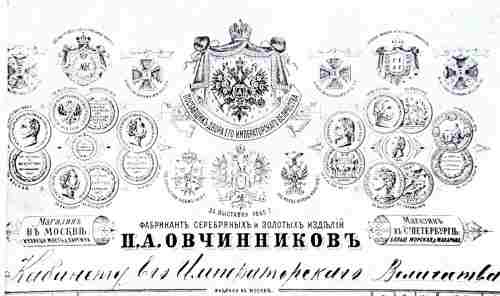 |
This month ASCAS presents the head of an invoice of
the Russian silversmith Ovchinikov.
The firm, founded in 1853 by Pavel Ovchinikov, was
managed after his death by his sons Mikhail, Alexander,
Pavel and Nikolai.
The company received the Imperial Warrant in 1883 and
its works were shown in many exhibitions, achieving
great success and winning many awards.
|
"A WORD per MONTH"
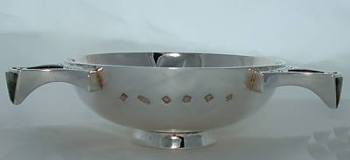
|
QUAICH
Quaich (cuaich in
Gaelic) meaning "cup", are a uniquely Scottish
invention. Having no apparent connection to any other
European drinking vessel they have maintained their
distinctive shape as a wide and shallow cup for more
than four hundred years. There are some scholars who
believe the shape evolved from the use of scallop
shells.....
more
|
"A SILVERSMITH per MONTH"
|
|
GARRARD & CO LTD
Founder of the firm was
John Wickes in 1722. In 1802 Robert Garrard (senior)
took the control of the firm active in Panton Street,
Haymarket, London. In 1818 he was succeed by his three
eldest sons, Robert Garrard Jr, James Garrard and
Sebastian Garrard trading as R, J & S. Garrard. The firm
became R. & S. Garrard in 1835, R. & S. Garrard & Co in
1843 and Garrard & Co Ltd in 1909. In 1952 the firm was
amalgamated with Goldsmiths & Silversmiths Co Ltd.....
more
|
"A BOOK ON MY SHELF"
In this column we present books, new
or ancient, dealing with silver in all its aspects (history,
marks, oddities...). This isn't a "book review" but only a fair
presentation of some useful "tools" that anyone may have in the
shelf of his bookcase.
ASCAS members are invited to contribute to this column
(click to enlarge images)
The "book on my shelf" of this month presents:
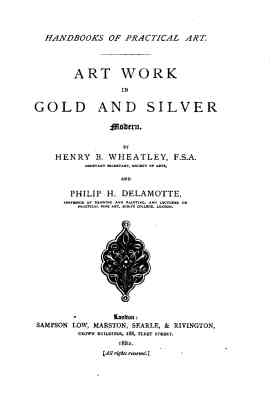 |
This is what the authors wrote
in their Editors' Note:
The chief aim of this series of Handbooks of Practical
Art is to bring to the notice of students and amateurs
of art, as well as all lovers of the highest excellence
in workmanship, numerous examples, both ancient and
modern, of the application of beautiful design to
articles of every-day use and to the various objects
which are frequently employed for purposes of
decoration.
Each book will contain an historical record of the
progress of the art of which it treats, from the
earliest times to the present, showing the distinctive
characteristics of the respective periods; and will be
illustrated with about forty to sixty engravings, which
will include representations of many of the most
remarkable specimens of industrial art that have been
preserved to us, and which now adorn the national
museums of Europe.
In making the selection, much care has been taken to
include only those works that are noteworthy, either for
the elegance of their form or the beauty of their
ornamentation; although a few objects have been chosen
for their historical interest, and for the purpose of
showing the style of art prevalent at the time in which
they were made.....
The whole book in pdf format (71 pages, 12,6 MB) is
freely available in ASCAS website click
here (be
patient, file downloading requests some minutes)
|
"A CREST per MONTH"
In this column we present images and
description of Crests and Mottoes of British, Irish and Scottish
Families as engraved in silver items.
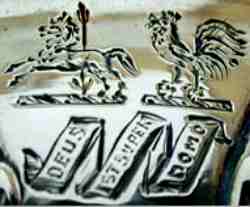 |
STRAKER of Durham
and another not identified
The crest is a horse at
full speed,
Motto: Deus Est Super Domo (the meaning would be
presumably God is over... 'the House', but the
sentence is not fully correct in Latin language)
Crest engraved on a salt cellar made by Garrard & Co,
London 1913
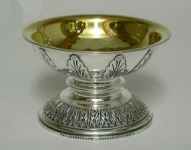
|
Closing our OCTOBER 2009 edition of ASCAS
Newsletter I hope you have appreciated its content.
Your comments, suggestions and advice will be of great help.
My thanks to Peter Barnes,
Robert Barry, Charles C. Cage, Paola Continella, Jayne Dye,
Geldolph Everts, Christophe Ginter, Della Green, Fritz Guercke,
Richard Hoskin, Robert Massart, David McKinley, Claudio Morelli,
José Luis Muñoz, David N. Nikogosyan, Eddie Robinson, for their
invaluable contributions.
Giorgio Busetto
Secretary
DISCLAIMER AND PRIVACY POLICY
ASCAS is a community of people having a common
interest in antique silver.
It is a non-profit association without commercial links.
Membership is open to whomever has a true interest in
this subject matter.
ASCAS has no real property and no fees are requested nor
accepted from members.
ASCAS keeps in touch with its members only through
periodical newsletters, e-mails and web-site updating
and ignores and is not responsible for any other
activity pursued by its members.
Likewise, ASCAS is not responsible for opinions,
evaluation and images displayed, and in any form
published or supplied for publication, by its members
who, in any case, maintain the property of their works
and assure the respect of national and international
legislation about Intellectual Property.
ASCAS does not have the full addresses of its members (only
town, country and e-mail address are requested for
membership).
ASCAS handles and protects with care its members' e-mail
addresses, will not disclose the addresses to third
parties, will use this information only to reply to
requests received from members and for communications
strictly related to its activity.
These rules are expressly accepted by submitting the
membership request.
|
|
 newsletter
# 65 OCTOBER 2009
newsletter
# 65 OCTOBER 2009






